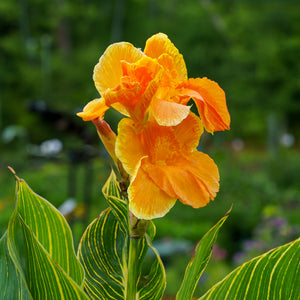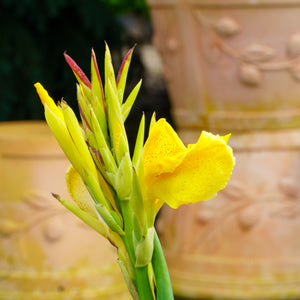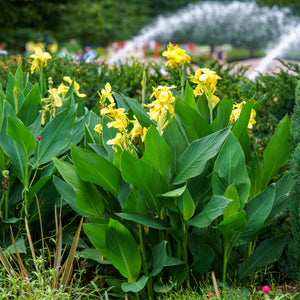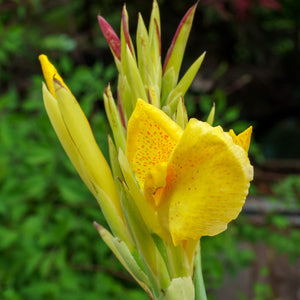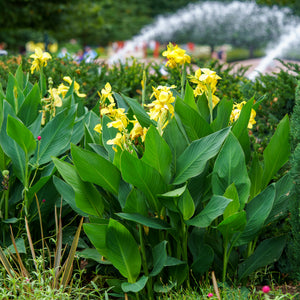The Canna Guide
Canna lilies are bold, tropical-looking plants grown for their vibrant flowers and striking foliage. Despite their name, Cannas are not true lilies but belong to their own plant family, Cannaceae. These fast-growing perennials are ideal for adding dramatic color and height to garden beds, containers, and water margins. With colorful blooms, lush leaves, and a long bloom season, Cannas make a big impact with minimal effort. Here's everything you need to know about growing and caring for Canna lilies.
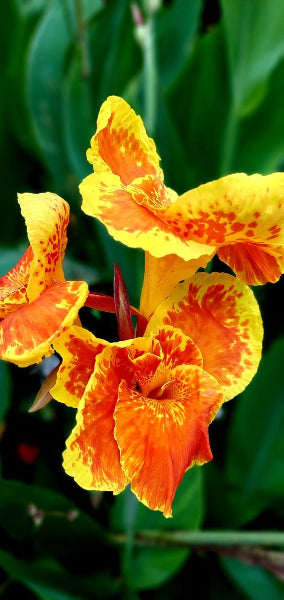
About
Cannas are native to tropical and subtropical regions of the Americas and are prized for their paddle-shaped foliage and brightly colored flowers. Leaves can be solid green, bronze, striped, or variegated, while flowers bloom in vivid shades of red, orange, yellow, and pink. Most varieties grow between 2 and 6 feet tall, though some dwarf forms remain more compact.
Popular varieties include Canna 'Tropicanna Gold', known for its striped green-and-yellow foliage and golden flowers; Canna 'Australia', with dark bronze leaves and deep red blooms; and Canna 'Cannova Bronze Orange', a compact hybrid with vivid orange flowers. Other stunning selections include Canna 'Cleopatra', which produces bicolor blooms, and Canna 'Stuttgart', a variegated variety with white-striped foliage.
Whether you're creating a tropical border, brightening up a container, or planting near a pond, Cannas bring bold energy and structure to any outdoor space.

PLANTING
- USDA Hardiness Zones: Perennial in Zones 7–11. In colder climates, grow as annuals or lift rhizomes in fall.
- Soil: Prefers rich, well-drained soil with ample organic matter. Tolerates clay if drainage is adequate.
- Sunlight: Thrives in full sun (6–8 hours of direct light). Partial shade is tolerated but may reduce flowering.
- Watering: Keep soil consistently moist but not waterlogged. Excellent for rain gardens or near water features.
- Spacing: Space plants 18–36 inches apart depending on the variety’s mature size.
- Planting Time: Rhizomes: Plant in spring after danger of frost has passed and soil has warmed. Transplants: Start indoors in colder zones or plant directly outdoors in late spring.
To plant Canna rhizomes, dig a hole 3–4 inches deep, place the rhizome horizontally with the eyes facing up, cover with soil, and water thoroughly.
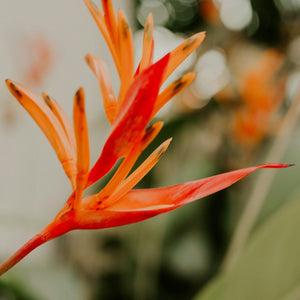
CARE
- Watering: Water regularly during the growing season, especially in dry spells. Cannas prefer moist soil.
- Fertilizing: Feed monthly with a balanced fertilizer to encourage lush foliage and continuous blooms.
- Deadheading: Remove spent flowers regularly to encourage reblooming. Trim flower stalks down to the foliage after all blooms fade.
- Pruning: Cut plants back to 6 inches above ground after the first frost or when overwintering indoors.
- Dividing: Lift and divide rhizomes every 2–3 years in spring to maintain vigor and control spread.
- Pests & Diseases: Generally pest-resistant, though Japanese beetles, slugs, and caterpillars may appear. Avoid waterlogged conditions to prevent rot.
- Overwintering: In Zones 6 and colder, lift rhizomes in fall, dry them, and store in a cool, dark, frost-free place.

HOW TO USE
Canna lilies offer bold structure and tropical flair, making them suitable for a variety of landscape applications:
- Garden Borders: Use taller varieties like Canna 'Bengal Tiger' or Canna 'Australia' as back-of-border focal points.
- Containers: Compact cultivars such as Canna 'Cannova Yellow' are perfect for patios and decks.
- Water Gardens: Cannas thrive near water and can be planted at pond edges or in boggy soil.
- Mass Plantings: Create bold visual impact with large groupings of a single color or variety.
- Tropical Gardens: Pair with elephant ears, coleus, and banana plants for a lush, exotic look.
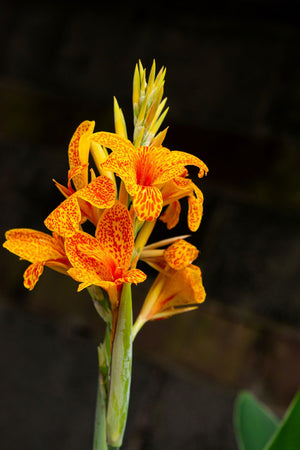
Common Questions
- What is a Canna rhizome? A Canna rhizome is a thick, underground stem that stores nutrients and produces roots and shoots. It is the primary way Cannas grow and spread.
- Are Canna lilies perennials? Yes, they are perennials in warm climates (Zones 7–11) and can be overwintered indoors elsewhere.
- Are Canna lilies poisonous to dogs? No, Cannas are non-toxic to dogs and safe for pet-friendly gardens.
- Do deer eat Canna lilies? Cannas are generally deer-resistant due to their tough, fibrous leaves.
- How to deadhead Canna lilies? Snip off faded flower spikes just above the next set of buds or leaves to encourage more blooms.
- How to grow Canna lilies? Plant rhizomes in full sun with rich, moist soil and feed monthly during the growing season.
- How to plant Canna lilies? Plant rhizomes 3–4 inches deep in warm soil in spring, spacing them based on variety.
- Are Canna lilies poisonous to cats? No, Cannas are also safe for cats and non-toxic.
- When do Canna lilies bloom? Cannas bloom from mid-summer to fall, with continuous flowering when deadheaded.
- Do Canna lilies spread? Yes, they spread slowly by underground rhizomes and can be divided every few years.
- How to prune Canna lilies? Cut back foliage after the first frost or in fall before overwintering.
- How to plant Canna lily bulbs? Rhizomes are planted like bulbs—place them horizontally, cover with 3–4 inches of soil, and water well.
Conclusion
Canna lilies are vibrant, architectural plants that bring dramatic height, texture, and color to garden beds and containers. With varieties like Canna 'Cleopatra', Canna 'Tenerife', and Canna x generalis 'Red Golden Flame', there’s a stunning option for every design palette. Easy to grow and non-toxic to pets, Cannas are an excellent choice for gardeners looking to make a bold statement from midsummer through fall. Explore our collection to find your perfect Canna.
The Canna Collection
Sold Out
Sold Out
Sold Out
Sold Out
Sold Out

